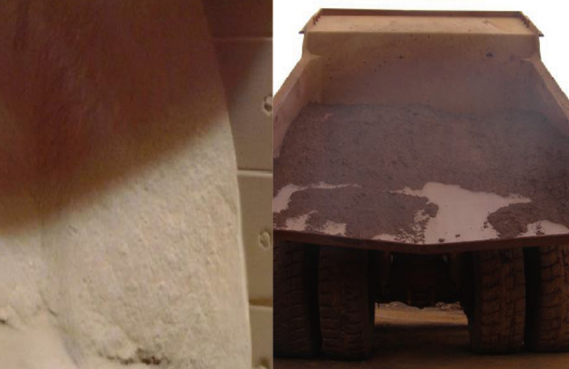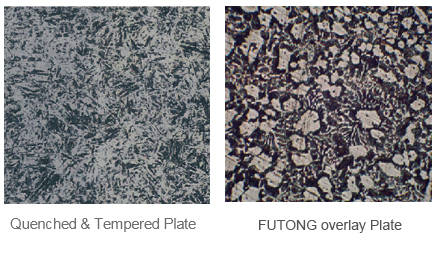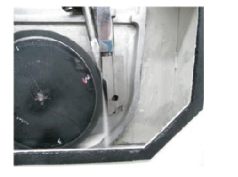Copyright © 2018 ChangZhou Futong Welding CO.,LTD.All Right Reserved. 苏ICP备14042014号 Powered by : www.300.cn
futong plant
Product Features
Revolutionary "FUTONG” is manufactured using advanced fusion bond welding technology to
apply a highly abrasive resistant chromium carbide on to a steel substrate producing
consistent chemistry and micro structure with smooth overlay deposit.
The formation of the high chromium carbide micro structure leads to a perfect abrasion
resistant bi-metallic plate.
High chromium carbide with high abrasion resistance and moderate to high impact properties.
SMOOTH SURFACE Chromium Carbide Overlay Plate
Reducing hang up / Carry back mobile
equipment an fixed plant
Hang up / Carry Back are the terms used to describe material sticking or binding to
a surface.
Buildup is costly as it reduces production efficiency, can cause millions of dollars in
lost productivity and decreases availability of plant and machinery.
Most material with either a high content of clay or water will have some type of hang
up carry back problem so FUTONG plates try to approach every hang up / carry back
application uniquely.
Fixed plant hang up
Mining truck carry back
Advantages Of FUTONG
Manufacturing Process |
Advantages |
|
Surface treatment before hardfacing |
Shot blasting |
Clean base metal surface to enhance fusion process |
Base plate pre-heat |
Pre-heat to set temperature |
Pre-heat to reduce residual stress |
Temperature held after weld |
Holding temperature for slow cooling process |
Pre-heat to reduce residual stress |
Cooling during welding |
Slow Cool |
Enhances mechanical strength of the base plate |
Finished plate flatness |
Even |
± 2.5mm per 1.5 linear metres |
Surface finish |
Smooth |
Designing for directional flow of material not necessary |
Friction co-efficient |
Low |
Excellent for reducing or eliminating hang up or carry back |
Visible surface weld bead |
No visible bead |
Smooth surface without weld beads |
Single pass overlay depth |
3 to 12mm |
Uniform microstructure and hardness |
Fusion dilution depth |
0.4 - 0.75 mm |
Low overlay dilution with backing plate. Wear rates become consistent and predictable |
Microstructure & Hardness consistency |
Uniform down to fusion line |
Consistent and predicable wear rates |
Operating temperature |
<600 ℃ |
Excellent high temperature wear rates |
FUTONG Smooth Overlay Plate |
|
Smooth surface finish |
Low friction co-efficient resulting in reduced hang up/carry back |
No weld beads |
Maximum wear resistance as directional flow of product over hardface overlay is not required |
Low dilution with a uniform fusion line between hardface overlay and backing plate |
Consistent hardness and microstructure resulting in consistent and predictable wear rates |
Minimal Surface Relief Cracks on Hardface Overlay |
Low residual stress between hardface overlay and backing plate resulting in ease for rolling and fabrication |
Bulk Weld Overlay plate |
|
Rough surface finish |
Product can built up on uneven surface |
Weld beads |
Directional flow of product over hardface weld bead critical to minimise wear rates |
High dilution and uneven fusion line between hardface overlay and backing plate |
High dilution results in accelerated wear rates as hardface overlay thickness starts to reduce |
Multiple surface relief cracks on hardface overlay |
High residual stress between hardface overlay and backing plate resulting in poor rolling and fabrication |
FUTONG Smooth Surface Overlay Plate VS Bulk Welded Overlay Plate
The materials microstructure and not its hardness determines abrasive resistance wear characteristics.
FUTONG has a dual metallurgical structure consisting of very hard carbides embedded in a soft matrix.
Quenched & Tempered steels have a predominately single metallurgical structure
Abrasion resistance is not related to hardness as hardness values only become relevant when comparisons are
made within a family of steels.
Chemical composition, microstructure & bulk hardness influence abrasion resistance
Abrasion resistance is not apparent in a hardness test but in a actual wear test such as ASTM G65.
Overlay plate are suitable for extremely severe abrasive wear and low to moderate impact. The structure of
overlay is a high proportion (up to 30% to 40%) of hard primary M7C3 chromium carbides in a eutectic matrix.
Reduction of Carry Back / Hang Up
MICROSTRUCTURE VS HARDNESS
FUTONG's unique manufacturing process offers a smooth overlay surface ensuring a low friction coefficient and combined with excellent abrasion resistant properties
greatly reduces or eliminates hang up / carry back.
Our specialized design team ensures a unique and specific anti hang up / carry back solution to each and every situation.
Product |
Force |
Rotation |
Rate |
Dia of wheel |
Sand size |
Loss weight |
Sample |
9 on 10 |
8.8kg |
3000r, 6000r |
120r.p.m |
250mm |
#6 |
300g/min |
17x25x60(mm) |
Abrasion Resistance & Testing
Low stress or scratching abrasion is the most predominant wear characteristic within the mining and associated industries with the wearing steel being abraded
away by removing slivers of steel.
The length of the metal sliver removed varies based upon the micro-structure and bulk hardness of the material being abraded.
ASTM G65
One of the more common tests to evaluate abrasive wear resistance in a variety of steel is the ASTM G65
sliding abrasion test.
This test measures the weight or volume loss in a very controlled environment and is commonly referred to
as low stress or scratching abrasion. The dry-sand, rubber-wheel apparatus (DSRW) produces data that will
rank products in their resistance to scratching abrasion under a set of conditions.
The value of this testing lies in predicting the ranking of materials in a relative order of merit as would
occur in an abrasive environment.
The ASTM G65 test gives a valuable insight into field performance.
Sliding Abrasion Results FT-M vs HB500
No. |
Grade |
Weight loss(g) |
|
3000r |
6000r |
||
#1 |
HB500 |
0.9371 |
1.8653 |
#2 |
M3 |
0.1041 |
0.1992 |
#3 |
M7 |
0.0668 |
0.1231 |
Turbulence and Wear
Wear is caused by a product flowing over a stationary surface.
An uneven material surface causes micro-turbulence of the product and can accelerate the wear rate of the material.
The weld beads on bulk weld overlay late generates turbulence that can lead to premature and costly failure of the wear liner. With no weld bends, FUTONG allows a
laminar flow of the product thereby greatly reducing wear rates.












